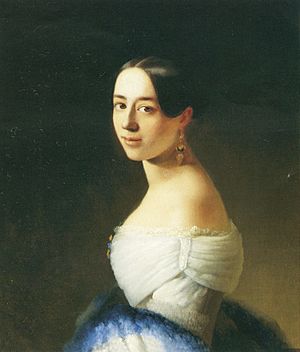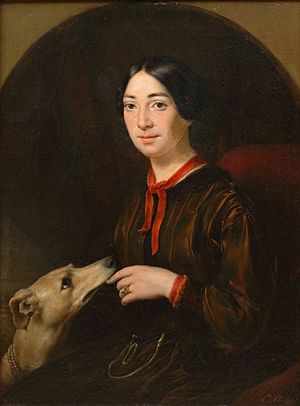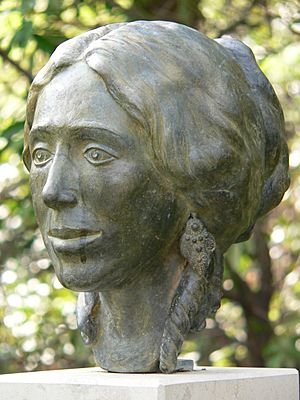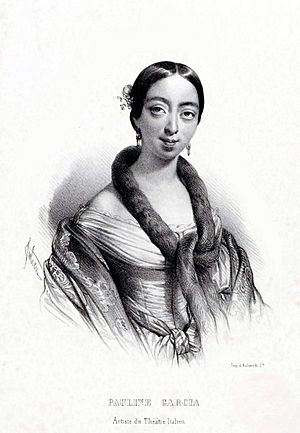Pauline Viardot facts for kids
Quick facts for kids
Pauline Viardot
|
|
|---|---|
 |
|
| Born |
Michelle Ferdinande Pauline García
18 July 1821 Paris, Kingdom of France
|
| Died | 18 May 1910 (aged 88) Paris, France
|
| Occupation |
|
Pauline Viardot (born Michelle Ferdinande Pauline García) was a famous French singer, teacher, and composer. She lived in the 1800s and early 1900s. She was born in Paris, France, on July 18, 1821.
Pauline came from a very musical family. She started learning music when she was very young. She became a professional performer as a teenager. She had a long and amazing career as a star singer. She was known for her powerful voice and dramatic stage performances.
Contents
Early Life and Musical Talents
Pauline Viardot was born in Paris. Her father, Manuel García, was a Spanish singing teacher and composer. Her mother, Joaquina Sitches, was also a Spanish singer and actress. Pauline's older sister, Maria Malibran, was a very famous singer too.
As a child, Pauline traveled with her family. They visited places like London, New York City, and Mexico. By age six, she could speak Spanish, French, English, and Italian. Later, she sang Russian songs so well people thought she was a native speaker.
Pauline loved playing the piano. She even took lessons from the famous composer Franz Liszt. She also studied music theory with Anton Reicha. She really wanted to be a professional pianist. However, her mother wanted her to focus on singing.
Pauline became a professional singer after her sister Maria died in 1836. But her first public performance was as a pianist. She played with her brother-in-law, the violinist Charles Auguste de Bériot.
A Star on Stage

In 1837, when she was 16, Pauline gave her first concert in Brussels. She made her opera debut in London in 1839. She sang the role of Desdemona in Rossini's Otello. People were very surprised by her talent. She had amazing singing skills and sang with great emotion.
When she was 17, Pauline met Louis Viardot. He was an author and a theater director. He was 21 years older than her. They got married on April 18, 1840. Louis became her career manager. He helped her a lot.
Pauline and Louis had children who also became musicians. Her son Paul was a violinist. Her daughter Louise Héritte-Viardot became a composer. Her other two daughters became singers.
Pauline's singing inspired many famous composers. These included Frédéric Chopin, Hector Berlioz, and Camille Saint-Saëns. She created important roles in operas like Meyerbeer's Le prophète. She was known for her wide vocal range.
She spoke many languages fluently. Her career took her to many music halls across Europe. From 1843 to 1846, she worked at the Opera in Saint Petersburg, Russia.
Pauline spent time with George Sand and Frédéric Chopin at Sand's home. Chopin gave her advice on her piano playing. He also helped her arrange some of his mazurkas into songs.
Pauline sang at Chopin's funeral in Paris in 1849. She sang a part of Mozart's Requiem. She performed it secretly behind a black curtain.
In 1859, she sang the main role in Gluck's opera Orphée et Eurydice. Hector Berlioz directed this performance. She sang this role over 150 times.
Later Years and Teaching
In 1863, Pauline Viardot stopped performing on stage. She and her family moved to Baden-Baden, Germany. This was because her husband disagreed with Emperor Napoleon III.
After Napoleon III's rule ended in 1870, they returned to France. Pauline taught at the Paris Conservatory. She also hosted a music salon at her home. Many famous musicians and artists visited her salon. Her students included many talented singers.
From the mid-1840s, Pauline was famous for her performances in Mozart's opera Don Giovanni. Her family had a long history with this opera. In 1855, she bought Mozart's original handwritten music for Don Giovanni. She kept it safely in her Paris home. Many famous people came to see it. She later gave it to the Conservatoire de Paris in 1892.
Compositions
Pauline Viardot started composing when she was young. She mostly wrote music for her students. These pieces helped them improve their singing skills. She wrote most of her compositions after she retired.
She was a very skilled musician. She was an excellent pianist and understood music deeply. Between 1864 and 1874, she wrote three short operas. These were Trop de femmes (1867), L'ogre (1868), and Le dernier sorcier (1869). The stories for these operas were written by Ivan Turgenev.
She also wrote over fifty songs. Her last two short operas were Le conte de fées (1879) and Cendrillon (1904). She wrote the stories for these herself. Even though her operas were small, they were written for advanced singers. Some of the music is quite challenging.
Opera
- Trop de femmes (1867)
- L'ogre (1868)
- Le dernier sorcier (1869)
- Le conte de fées (1879)
- Cendrillon (1904)
Choral Music
- Choeur bohémien
- Choeur des elfes
- Choeur de fileuses
- La Jeune République
Songs
- Album de Mme Viardot-Garcia (1843)
- L'Oiseau d'or (1843)
- 12 Mazurkas for voice and piano (based on Chopin's works, 1848)
- Duo, 2 solo voices and piano (1874)
- 100 songs (including 5 Gedichte, 1874)
- 4 Lieder (1880)
- 5 Poésies toscanes-paroles (1881)
- 6 Mélodies (1884)
- Airs italiens du XVIII siècle (1886)
- 6 chansons du XVe siècle
- Album russe
- Canti popolari toscani
- Vocal arrangements of instrumental works by Johannes Brahms, Joseph Haydn and Franz Schubert
Instrumental Music
- 2 airs de ballet for piano (1885)
- Défilé bohémien for piano 4 hands (1885)
- Introduction et polonaise for piano 4 hands (1874)
- Marche militaire for 2 flutes and piccolo, 2 oboes, 2 brass choirs (1868)
- Mazourke for piano (1868)
- 6 morceaux for violin and piano (1868)
- Second album russe for piano (1874)
- Sonatine for violin and piano (1874)
- Suite arménienne for piano for four hands
Death
Pauline Viardot died on May 18, 1910, at the age of 88. She is buried in the Montmartre Cemetery in Paris, France.
Images for kids
See also
 In Spanish: Pauline Viardot-García para niños
In Spanish: Pauline Viardot-García para niños






